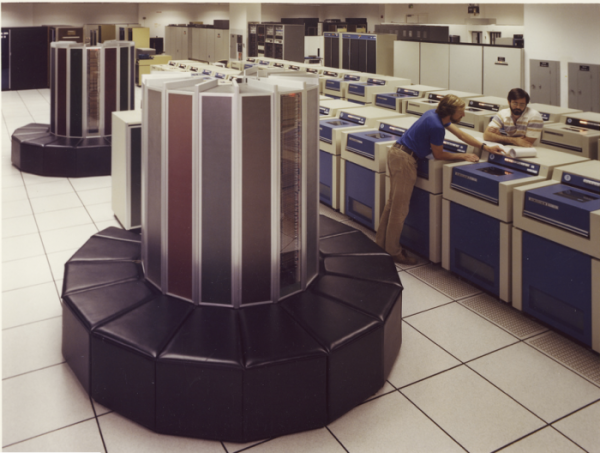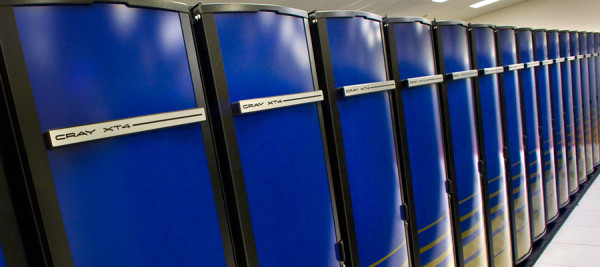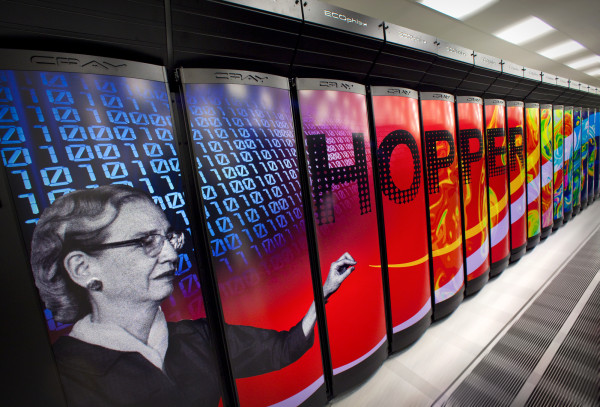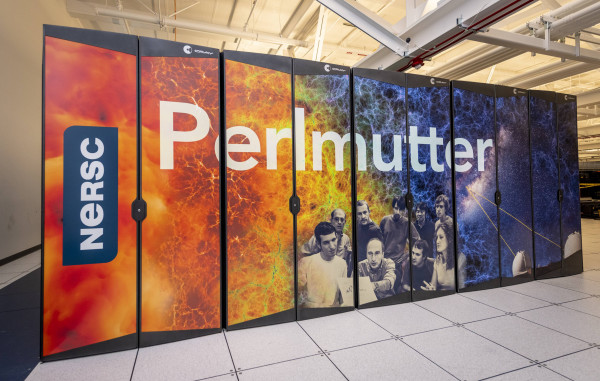50 Years of NERSC Firsts
Celebrating growth and milestones from five decades of HPC
January 25, 2024
Contact: cscomms@lbl.gov
From its humble beginnings in 1974, NERSC has expanded in both supercomputing capabilities and user services, achieving "firsts" as a center and for HPC more broadly. Here are some hits and highlights from those first 50 years:
1974
In July, local researchers begin running jobs at the Controlled Thermonuclear Research (CTR) Computer Center at LLNL on a borrowed Control Data Corp. 6600 computer (serial number 1), giving them access to a machine once reserved for defense-related research.

The Cray-1 sold for about $8 million in 1978 (around $38 million in inflation-adjusted dollars).
1975
A new CDC 7600 computer is installed at the center in September. Remote users connect through the CDC 6600’s 16 acoustically coupled dial-up ports.
1976
The CTR Computer Center is renamed the National Magnetic Fusion Energy Computer Center.
1978
In May, the NMFECC receives a new Cray-1 with a peak speed of 138 megaflops. NMFECC undertakes a major software project to convert the 7600 operating system (LTSS or Livermore Time Sharing System), utilities, and libraries to the new Cray-1.
1984
To accommodate NERSC’s growing user base, which now numbers 3,500, a Cray X-MP is added to the NMFECC. The arrival of the new machine and the addition of 500 new users produces a heavy workload for the consultants, rocketing the number of contacts from 25 to more than 100 per day.
1985
The center acquires the first Cray-2 supercomputer (serial number 1), the most powerful computer in the world at the time. The four-processor machine, along with the two-processor X-MP, allows multiprocessing of codes, which greatly accelerates the speed of computing.

The world's first Cray-2 was installed at NERSC (then called the NMFECC) in 1985.
1987
The broadening role of NMFECC in supporting DOE programs finds nearly a third of the computing resources going to projects other than fusion research. The Basic Energy Sciences program accounts for nearly 15% of the total allocations, health and environment 14%, high energy and nuclear physics 12%, and applied math 2.5%.
1990
The center is renamed the National Energy Research Supercomputing Center, or NERSC, to reflect its broadened mission.
1993
In June, the Top 500 list of supercomputer sites around the world debuts. NERSC’s Cray C-90 places number 24 on the list.
1995
In April, DOE requests that Lawrence Livermore National Laboratory and Lawrence Berkeley National Laboratory submit proposals on the future operation of NERSC. In November, DOE announces its decision to relocate NERSC to Berkeley Lab.
1996
NERSC makes the move to Berkeley Lab.
1999
Now settled in its new Berkeley home, NERSC installs an IBM RS/6000 SP supercomputer as its flagship system and names it “Seaborg” in honor of Berkeley Lab Nobel Laureate Glenn Seaborg. At its peak, it performed about 10 trillion calculations per second (10 teraflop/s).

The “Franklin” Cray XT4 was the first NERSC computer to make the top 10 in the Top 500 list.
2000
In November, NERSC’s computing and storage systems move from Berkeley Lab’s main site to the Oakland Scientific Facility in downtown Oakland.

“Hopper,” a Cray XE6 installed at NERSC in 2010, was named in honor of computing pioneer Rear Admiral Grace Murray Hopper.
2007
In 2007, NERSC’s Franklin Cray XT4 computer ranks ninth in the world on the Top 500 list, the first time a NERSC computer places among the top 10.
2010
NERSC’s first petaflop system, a Cray XE6 named “Hopper” in honor of computing pioneer Grace Hopper, places number 5 on the November 2010 Top500 Supercomputer list.
2013
NERSC installs its fastest supercomputer yet: “Edison,” a Cray XC30 named in honor of American inventor and entrepreneur Thomas Alva Edison.
2015
NERSC moves from its Oakland Scientific Facility into a new state-of-the-art facility on the main Berkeley Lab Campus. Named Shyh Wang Hall, the 149,000 square-foot facility houses NERSC, ESnet, and the Berkeley Lab Computational Research Division.

The “Cori” system was named in honor of biochemist Gerty Cori, the first American woman to win a Nobel Prize in the sciences and the first woman ever to win a Nobel Prize in Physiology or Medicine.
2017
NERSC’s Cori system, which debuted at number 5 on the Top 500 List of the world’s most powerful supercomputers, is installed in two phases during 2015 and 2016 and officially accepted in 2017. Cori is the first supercomputer to field the Intel Xeon Phi power-efficient processor at scale. The system also features a novel flash-based “burst buffer” file system that can read and write data at a rate greater than 1.5 TB/sec, a record at the time.
2020
Berkeley Lab’s decades of expertise in energy-efficient data centers begins to be applied to NERSC resources through the Efficiency Optimization Project, a collaboration between NERSC, the Energy Technologies Area, and Sustainable Berkeley Lab. The project uses operational data analytics to optimize cooling systems and save electricity.
2021
NERSC officially unveils the Perlmutter system. Due to its hybrid CPU/GPU architecture, some coverage proclaim it the “world’s largest artificial intelligence system.” Phase I of the system, still in preproduction testing, places at number 5 in the Top500 fastest computers in the world that year.

Phase I of Perlmutter was ranked fifth in 2021’s Top500 fastest supercomputers in the world.
2022
Phase II of Perlmutter is installed and goes into production mode later in the year.
Recognizing that a combination of quantum and classical computing will be key to the application and adoption of quantum information resources, NERSC establishes the QIS@Perlmutter program to prepare for the day QIS-enabled computing will be available to its user community.
2023
Two research teams are awarded, respectively, the 2023 ACM Gordon Bell Prize and the first-ever Gordon Bell Climate Modeling Prize during SC23. Both used the Perlmutter supercomputer as part of their winning projects.
About NERSC and Berkeley Lab
The National Energy Research Scientific Computing Center (NERSC) is a U.S. Department of Energy Office of Science User Facility that serves as the primary high-performance computing center for scientific research sponsored by the Office of Science. Located at Lawrence Berkeley National Laboratory, the NERSC Center serves almost 10,000 scientists at national laboratories and universities researching a wide range of problems in climate, fusion energy, materials science, physics, chemistry, computational biology, and other disciplines. Berkeley Lab is a DOE national laboratory located in Berkeley, California. It conducts unclassified scientific research and is managed by the University of California for the U.S. Department of Energy. »Learn more about computing sciences at Berkeley Lab.
About Computing Sciences at Berkeley Lab
High performance computing plays a critical role in scientific discovery. Researchers increasingly rely on advances in computer science, mathematics, computational science, data science, and large-scale computing and networking to increase our understanding of ourselves, our planet, and our universe. Berkeley Lab’s Computing Sciences Area researches, develops, and deploys new foundations, tools, and technologies to meet these needs and to advance research across a broad range of scientific disciplines.







 Instagram
Instagram YouTube
YouTube